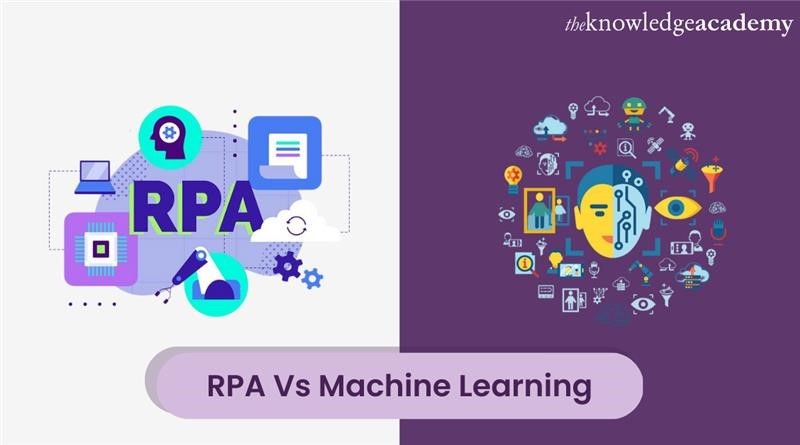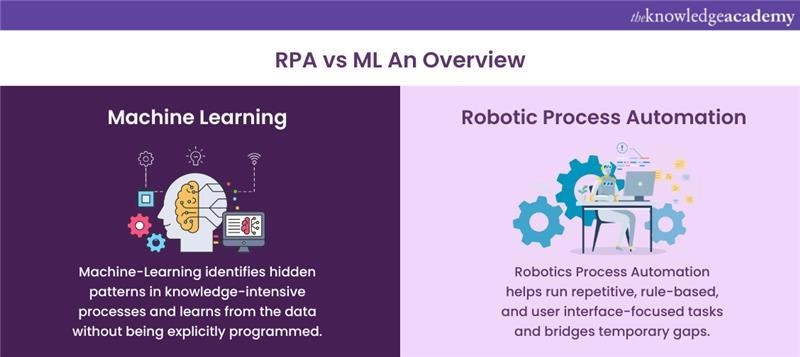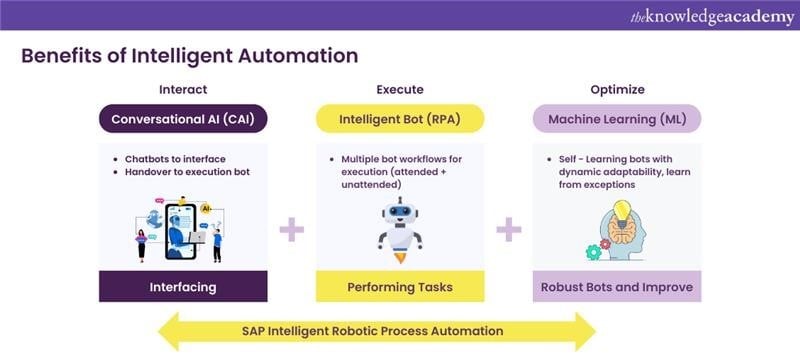We may not have the course you’re looking for. If you enquire or give us a call on +1 7204454674 and speak to our training experts, we may still be able to help with your training requirements.
Training Outcomes Within Your Budget!
We ensure quality, budget-alignment, and timely delivery by our expert instructors.

Machine learning (ML) allows an Artificial Intelligence (AI) suite to adapt to its environment, learn from it and grow smarter. Similarly, Robotic Process Automation (RPA) allows the execution of a repetitive and boring menial task with great efficiency. So, does this make them both similar? After all, they both work with Artificial Intelligence and automation. If that is the case, then which one is the better two? What is the right choice for enterprises in RPA vs Machine Learning?
According to Statista, the adoption rate for AI has grown significantly in 2022. The adoption rate for RPA has increased to 39%, while adoption rates for ML methods like Reinforced Learning grew to 20%, and Deep Learning grew to 30%. Doesn’t this make you curious about their similarities and differences? If you are wondering about the general similarities and differences between both fields, this blog is just for you. Machine Learning vs RPA: This blog briefly clarifies the differences between Robotic Process Automation and Machine Learning. Read more!
Table of contents
1) Robotic Process Automation vs Machine Learning: an overview
a) Intelligence
b) Convenience
2) Which choice is better in RPA vs Machine Learning
3) Combining Machine Learning and RPA
4) Conclusion
Robotic Process Automation vs Machine Learning: an overview
RPA and ML are vital parts of automation achieved through years of trial and error. To draw a fair parallel between the two, it is necessary to understand what they both are and what they stand for. Let's start with ML. It is a trial-and-failure method of developing Artificial Intelligence. ML utilises algorithms to learn from large databases, which are later utilised to form meaningful applications.
Now moving on to Robotic Process Automation (RPA) it is a process of robots or machines imitating human actions. These behaviours generally include boring, hectic and redundant menial tasks. The machine’s inability to get bored or lose interest makes it highly proficient at these tasks. It is great for large-scale tasks of grand volumes and bringing consistency. Naturally, they both played a vital part in digitalised businesses, but they differ. Let's see some differences between both fields.

Fascinated by ML? Why not try our course in Machine Learning Training!
Intelligence
Starting with RPA - it is a simple automation that runs on programmed scripts. RPAs are extremely efficient at imitating human actions but cannot learn from them. Any growth within an RPA’s capabilities strictly relies on the updates from its vendors. An example of this would be automation, created to pick heavy will be efficient at it but won’t get better in the future.
RPA also depends on a human employee to give instructions, which it will follow tirelessly. In comparison, ML is more of a learning than a working process, and ML can make a system or process grow more intelligent over time.
This makes ML capable of understanding and processing human behaviour, not just action. ML is also virtually limitless in growth potential. Theoretically, developing an AI that needs zero human assistance with ML is possible.
Convenience
Robotic Process Automation allows you to build an enterprise with the least potential for human error. RPA can interact with its environment in the same fashion a human can, and this allows RPA to operate other machinations with ease. This makes RPA extremely convenient to use and implement. While in negative hindsight, it cannot learn and grow, it also can’t make unpredictable mistakes. They are used for simple tasks such as opening and sending mail, carrying data and calculating simple data.
ML is comparatively complex and capable of performing a greater function. ML is commonly used to perform large-scale analytics and make a prediction based on data patterns. It is also less dependent on human support due to decision-making ability. This ability is possible due to trial and error-based Artificial Intelligence. ML has an advantage over RPA in terms of convenience as it has the ability to process unstructured convoluted data.
Which choice is better in RPA vs Machine Learning
RPA and ML are essentially just two entities on different scales of the same spectrum. They both reduce human efforts and ease a process, automating it. The real question you need to ask isn’t which is better, but rather what the right context of their usage is. RPA is a great choice for structured data found in simple data types in tables, spreadsheets and forms.
Where RPA demonstrates its ability with actual functioning and actions, ML does that by backing up the decisions behind it. ML enables methodologies that make processes like RPA much more efficient. Features like Natural Language Processing (NLP) enable command machines like RPA with only voice commands. Combining both technologies allows you to accomplish feats which were once considered impossible.
Interested in the creation of RPA Bots? Try our course OpenSpan RPA Training today!
Combining Machine Learning and RPA
If you treat RPA and ML as different fields' specialities rather than alternatives, you realise you can benefit from integrating both. This is exactly what intelligent automation strives to achieve. Intelligent automation is a concept that encourages the development of ML and Deep Learning in RPA. Some common applications will be as follows.

Support desk and review
Intelligent automation allows you to automate hectic work, which might be too bothersome for your employees. Since customer support fields directly work with collecting data, it also allows Intelligent automation to grow and learn as it works. Some common examples of this would automate employee verification, automated approvals and chatbot integrations.
Document processing
ML integration within Automated robots will allow them to use NLP and Optical Character Recognition. This allows it to deal with convoluted and messy data, which would require too much human effort and time normally. This will also allow intelligent automation to read your data and categorise them in order.
This will make your overall data much more streamlined than before but also allow them to be used more efficiently by employees.
Eager to learn more about Robotic Process Automation, refer to our blog on "RPA testing"
Single Source of Truth (SSOT)
SSOT focuses on forming a cohesive, centralised insight from distributed data sources. The concept of a centralised data source was called a “Single Source of Truth”. Technologies like cloud-based computing support this, and such online technologies allow for easy scale-up of automated SSOT systems.
Regulatory compliances
Compliances refer to reinforcing and regulating an employee's dedication to an organisation’s policy. Automation makes it easier to keep track of regulatory compliances, which can be hectic to do manually. Proper compliance with regulation can prevent an organisation from going through heavy fines and legal actions. This is made possible by RPA Machine Learning automatically enforcing compliance in all instances.
Periodic Update
All enterprises require occasional updates from their employees, which helps them keep track of consistency and progress. However, this process is often complicated and liable to human errors. Creating intelligent robotic automation allows you to streamline this process and has the added benefit of automation getting smarter with time and improving data arrangement.
Conclusion
RPA has existed in enterprise and everyday life for a while. In comparison, ML and AI is still a relatively new field with unknown potential. With the integration of ML, an RPA can be expanded to a greater scale. With this blog, you know the general similarities and differences between RPA vs Machine Learning. Hope this will allow you to make informed choices if you wish to make use of these technologies.
Interested in RPA solutions? Try our Microsoft Power Automate RPA Developer PL500 course!
Frequently Asked Questions
Upcoming Data, Analytics & AI Resources Batches & Dates
Date
 Machine Learning Course
Machine Learning Course
Fri 17th Jan 2025
Fri 21st Feb 2025
Fri 4th Apr 2025
Fri 6th Jun 2025
Fri 25th Jul 2025
Fri 7th Nov 2025
Fri 26th Dec 2025







 Top Rated Course
Top Rated Course



 If you wish to make any changes to your course, please
If you wish to make any changes to your course, please


